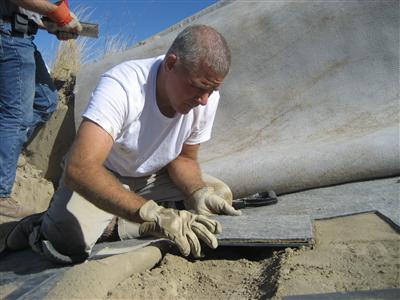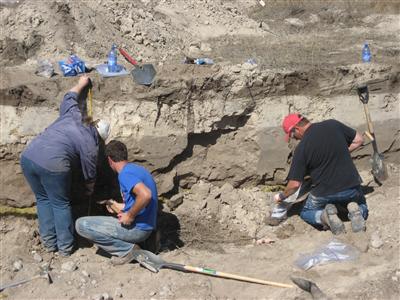
Credit: Image provided by Craig Benson
May 23, 2012
By Marie Zhuikov
Not many people can say their work will last for hundreds or thousands of years, but that’s the time scale Craig Benson, UW-Madison professor of geological, civil and environmental engineering, deals with every day. Benson is leading a Water Resources Institute project to evaluate the long-term performance of covers and barrier systems for low-level radioactive waste disposal and uranium mill tailings sites across the country. His revolutionary findings, which take nature into account, have gained attention or funding by the Nuclear Regulatory Commission, the U.S. Geological Survey, the U.S. Department of Energy and other high-level groups.
“I knew the findings would be important,” said Benson. “But the attention they’ve gained has been even more than I expected. It’s exciting to see your work have that level of relevance in the real world.”
The project builds on a previous study of the field performance of cover systems for waste containment. The issue, as Benson described it, is that, “We are designing systems to last a millennium and have little understanding about how they evolve over time from an engineering perspective.”
Benson said the cover is the most important feature in terms of long-term performance and protection of the public and the environment from the wastes the sites contain. An army of graduate students and post-docs, along with a consortium of federal agencies and private-sector companies, joined the project, which involved constructing, monitoring and dissecting different barrier and cover systems in facilities across the U.S. While some aspects of the covers behaved as expected, researchers found that others changed dramatically over time due to local environmental conditions like rain and erosion.
For Benson’s current project, researchers dug into the test facilities to assess how the various barriers fared over time. One lesson they learned is that the more incongruently a system was engineered compared to the local environment, the more quickly natural processes would work to make it congruent with the environment. Systems built more in harmony with the local environment changed less quickly.
“Physical, biological and chemical properties change over time,” Benson explained. “We should expect engineered systems that are at or near the surface to do the same thing.” As the systems get wet and dry, freeze and thaw, feel the effects of plant roots and insects building homes in them, changes are going to happen, Benson said. These changes involve the rate at which liquids precipitate through the containment cover and into the underlying waste.

Credit: Image provided by Craig Benson
The other lesson they learned is despite where in the country containment facilities were built, their end conditions varied little after a certain time. “Although some systems changed more rapidly than others, their final states were remarkably similar,” Benson said.
Benson said the findings jibe with what Canadians and Australians are learning. “We are all finding that nature is this big equalizer,” Benson said. “We used to assume that our engineering properties were functioning the same over time and they aren’t.” This has caused state agencies, the Nuclear Regulatory Commission and other authorities to think about containment system design differently. The project’s final report (nrc.gov/reading-rm/doc-collections/nuregs/contract/cr7028/) was delivered this past January and is causing a philosophical change in the industry.
“We recommend now that engineers approach design in a way that mimics the natural environment,” Benson said. “If the natural system in the area where you’re locating a facility is not conducive to long-term control of fluids and gasses, maybe we ought not put the waste in that environment.”
Benson said that bio-mimicing facilities are more sustainable and require less maintenance, which means they are less costly in the long run.



